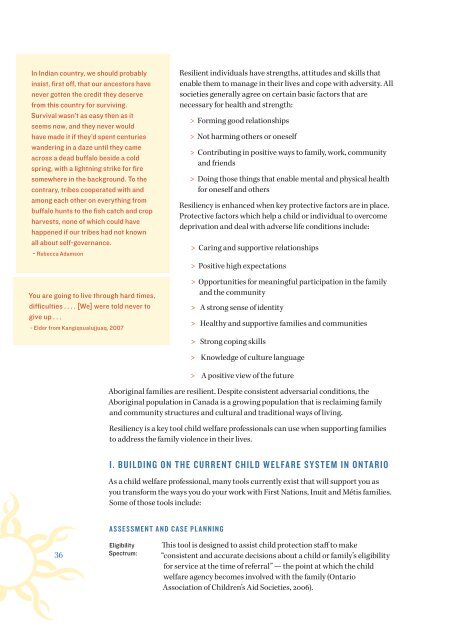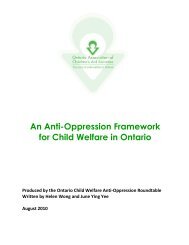English - Ontario Association of Children's Aid Societies
English - Ontario Association of Children's Aid Societies
English - Ontario Association of Children's Aid Societies
Create successful ePaper yourself
Turn your PDF publications into a flip-book with our unique Google optimized e-Paper software.
In Indian country, we should probably<br />
insist, first <strong>of</strong>f, that our ancestors have<br />
never gotten the credit they deserve<br />
from this country for surviving.<br />
Survival wasn’t as easy then as it<br />
seems now, and they never would<br />
have made it if they’d spent centuries<br />
wandering in a daze until they came<br />
across a dead buffalo beside a cold<br />
spring, with a lightning strike for fire<br />
somewhere in the background. To the<br />
contrary, tribes cooperated with and<br />
among each other on everything from<br />
buffalo hunts to the fish catch and crop<br />
harvests, none <strong>of</strong> which could have<br />
happened if our tribes had not known<br />
all about self-governance.<br />
- Rebecca Adamson<br />
You are going to live through hard times,<br />
difficulties . . . . [We] were told never to<br />
give up . . . <br />
- Elder from Kangiqsualujjuaq, 2007<br />
Resilient individuals have strengths, attitudes and skills that<br />
enable them to manage in their lives and cope with adversity. All<br />
societies generally agree on certain basic factors that are<br />
necessary for health and strength:<br />
> Forming good relationships<br />
> Not harming others or oneself<br />
> Contributing in positive ways to family, work, community<br />
and friends<br />
> Doing those things that enable mental and physical health<br />
for oneself and others<br />
Resiliency is enhanced when key protective factors are in place.<br />
Protective factors which help a child or individual to overcome<br />
deprivation and deal with adverse life conditions include:<br />
> Caring and supportive relationships<br />
> Positive high expectations<br />
> Opportunities for meaningful participation in the family<br />
and the community<br />
> A strong sense <strong>of</strong> identity<br />
> Healthy and supportive families and communities<br />
> Strong coping skills<br />
> Knowledge <strong>of</strong> culture language<br />
> A positive view <strong>of</strong> the future<br />
Aboriginal families are resilient. Despite consistent adversarial conditions, the<br />
Aboriginal population in Canada is a growing population that is reclaiming family<br />
and community structures and cultural and traditional ways <strong>of</strong> living.<br />
Resiliency is a key tool child welfare pr<strong>of</strong>essionals can use when supporting families<br />
to address the family violence in their lives.<br />
I. BUILDING ON THE CURRENT CHILD WELFARE SYSTEM IN ONTARIO<br />
As a child welfare pr<strong>of</strong>essional, many tools currently exist that will support you as<br />
you transform the ways you do your work with First Nations, Inuit and Métis families.<br />
Some <strong>of</strong> those tools include:<br />
ASSESSMENT AND CASE PLANNING<br />
36<br />
Eligibility<br />
Spectrum:<br />
This tool is designed to assist child protection staff to make<br />
“consistent and accurate decisions about a child or family’s eligibility<br />
for service at the time <strong>of</strong> referral” — the point at which the child<br />
welfare agency becomes involved with the family (<strong>Ontario</strong><br />
<strong>Association</strong> <strong>of</strong> Children’s <strong>Aid</strong> <strong>Societies</strong>, 2006).

















